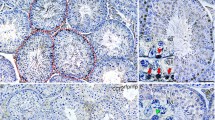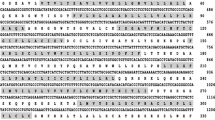Abstract
The chemokine receptor CXCR7 interacts with the chemokines CXCL11 and CXCL12. During development, this ligand receptor system (C-X-C) provokes cell-type-specific responses in terms of migration, adhesion or ligand sequestration. It is active in zebrafish and rodents but no data are available for its presence or function in primate testes. Real-time quantitative polymerase chain reaction was performed in monkeys to detect CXCL11, CXCL12 and CXCR7. At the protein level, CXCL12 and CXCR7 were localized in the testes of the marmoset (Callitrix jacchus) whereas CXCR7 patterns were determined for various stages in human testes. Morphometry and flow cytometry were applied to quantify CXCR7-positive cells in monkeys. Transcript levels and protein expression of CXCR7 were detectable throughout testicular development. In both species, CXCR7 protein expression was restricted to premeiotic germ cells. In immature marmoset testes, 69.9 % ± 9 % of the total germ cell population were labelled for CXCR7, whereas in the adult, 4.7 % ± 2.7 % were positive for CXCR7. CXCL12 mRNA was detectable in all developmental stages in marmosets. The CXCL12 protein was exclusively localized to Sertoli cells. This pattern of CXCL12/CXCR7 indicates their involvement in regulatory processes that possibly orchestrate the interaction between undifferentiated germ cells and Sertoli cells.







Similar content being viewed by others
References
Albert S, Ehmcke J, Wistuba J, Eildermann K, Behr R, Schlatt S, Gromoll J (2010) Germ cell dynamics in the testis of the postnatal common marmoset monkey (Callithrix jacchus). Reproduction 140:733–742
Albert S, Wistuba J, Eildermann K, Ehmcke J, Schlatt S, Gromoll J, Kossack N (2012) Comparative marker analysis after isolation and culture of testicular cells from the immature marmoset. Cells Tissues Organs 196:543–554
Ara T, Nakamura Y, Egawa T, Sugiyama T, Abe K, Kishimoto T, Matsui Y, Nagasawa T (2003) Impaired colonization of the gonads by primordial germ cells in mice lacking a chemokine, stromal cell-derived factor-1 (SDF-1). Proc Natl Acad Sci U S A 100:5319–5323
Balabanian K, Lagane B, Infantino S, Chow KY, Harriague J, Moepps B, Arenzana-Seisdedos F, Thelen M, Bachelerie F (2005) The chemokine SDF-1/CXCL12 binds to and signals through the orphan receptor RDC1 in T lymphocytes. J Biol Chem 280:35760–35766
Bergmann M, Kliesch S (2010) Testicular biopsy and histology. In: Nieschlag E (ed) Andrology, male reproductive health and dysfunction. Springer, Berlin, pp 155–167
Bhakta S, Hong P, Koc O (2006) The surface adhesion molecule CXCR4 stimulates mesenchymal stem cell migration to stromal cell-derived factor-1 in vitro but does not decrease apoptosis under serum deprivation. Cardiovasc Revasc Med 7:19–24
Boldajipour B, Mahabaleshwar H, Kardash E, Reichman-Fried M, Blaser H, Minina S, Wilson D, Xu Q, Raz E (2008) Control of chemokine-guided cell migration by ligand sequestration. Cell 132:463–473
Brinkworth MH, Weinbauer GF, Schlatt S, Nieschlag E (1995) Identification of male germ cells undergoing apoptosis in adult rats. J Reprod Fertil 105:25–33
Burns JM, Summers BC, Wang Y, Melikian A, Berahovich R, Miao Z, Penfold ME, Sunshine MJ, Littman DR, Kuo CJ, Wei K, McMaster BE, Wright K, Howard MC, Schall TJ (2006) A novel chemokine receptor for SDF-1 and I-TAC involved in cell survival, cell adhesion, and tumor development. J Exp Med 203:2201–2213
Cancellieri C, Vacchini A, Locati M, Bonecchi R, Borroni EM (2013) Atypical chemokine receptors: from silence to sound. Biochem Soc Trans 41:231–236
Comerford I, Litchfield W, Harata-Lee Y, Nibbs RJ, McColl SR (2007) Regulation of chemotactic networks by “atypical” receptors. Bioessays 29:237–247
Dambly-Chaudiere C, Cubedo N, Ghysen A (2007) Control of cell migration in the development of the posterior lateral line: antagonistic interactions between the chemokine receptors CXCR4 and CXCR7/RDC1. BMC Dev Biol 7:23
Decaillot FM, Kazmi MA, Lin Y, Ray-Saha S, Sakmar TP, Sachdev P (2011) CXCR7/CXCR4 heterodimer constitutively recruits beta-arrestin to enhance cell migration. J Biol Chem 286:32188–32197
Doitsidou M, Reichman-Fried M, Stebler J, Koprunner M, Dorries J, Meyer D, Esguerra CV, Leung T, Raz E (2002) Guidance of primordial germ cell migration by the chemokine SDF-1. Cell 111:647–659
Eva C, Sprengel R (1993) A novel putative G protein-coupled receptor highly expressed in lung and testis. DNA Cell Biol 12:393–399
Gilbert DC, Chandler I, McIntyre A, Goddard NC, Gabe R, Huddart RA, Shipley J (2009) Clinical and biological significance of CXCL12 and CXCR4 expression in adult testes and germ cell tumours of adults and adolescents. J Pathol 217:94–102
Guazzone VA, Jacobo P, Theas MS, Lustig L (2009) Cytokines and chemokines in testicular inflammation: a brief review. Microsc Res Tech 72:620–628
Kanatsu-Shinohara M, Inoue K, Takashima S, Takehashi M, Ogonuki N, Morimoto H, Nagasawa T, Ogura A, Shinohara T (2012) Reconstitution of mouse spermatogonial stem cell niches in culture. Cell Stem Cell 11:567–578
Kortesidis A, Zannettino A, Isenmann S, Shi S, Lapidot T, Gronthos S (2005) Stromal-derived factor-1 promotes the growth, survival, and development of human bone marrow stromal stem cells. Blood 105:3793–3801
Lazarini F, Tham TN, Casanova P, Arenzana-Seisdedos F, Dubois-Dalcq M (2003) Role of the alpha-chemokine stromal cell-derived factor (SDF-1) in the developing and mature central nervous system. Glia 42:139–148
Levoye A, Balabanian K, Baleux F, Bachelerie F, Lagane B (2009) CXCR7 heterodimerizes with CXCR4 and regulates CXCL12-mediated G protein signaling. Blood 113:6085–6093
Li LH, Donald JM, Golub MS (2005) Review on testicular development, structure, function, and regulation in common marmoset. Birth Defects Res B Dev Reprod Toxicol 74:450–469
Lin ZY, Imamura M, Sano C, Nakajima R, Suzuki T, Yamadera R, Takehara Y, Okano HJ, Sasaki E, Okano H (2012) Molecular signatures to define spermatogenic cells in common marmoset (Callithrix jacchus). Reproduction 143:597–609
Liu H, Xue W, Ge G, Luo X, Li Y, Xiang H, Ding X, Tian P, Tian X (2010) Hypoxic preconditioning advances CXCR4 and CXCR7 expression by activating HIF-1alpha in MSCs. Biochem Biophys Res Commun 401:509–515
Livak KJ, Schmittgen TD (2001) Analysis of relative gene expression data using real-time quantitative PCR and the 2(−delta delta C(T)) method. Methods 25:402–408
Luker K, Gupta M, Luker G (2009) Bioluminescent CXCL12 fusion protein for cellular studies of CXCR4 and CXCR7. Biotechniques 47:625–632
Mahabaleshwar H, Boldajipour B, Raz E (2008) Killing the messenger: the role of CXCR7 in regulating primordial germ cell migration. Cell Adh Migr 2:69–70
Mahabaleshwar H, Tarbashevich K, Nowak M, Brand M, Raz E (2012) Beta-arrestin control of late endosomal sorting facilitates decoy receptor function and chemokine gradient formation. Development 139:2897–2902
Mazzinghi B, Ronconi E, Lazzeri E, Sagrinati C, Ballerini L, Angelotti ML, Parente E, Mancina R, Netti GS, Becherucci F, Gacci M, Carini M, Gesualdo L, Rotondi M, Maggi E, Lasagni L, Serio M, Romagnani S, Romagnani P (2008) Essential but differential role for CXCR4 and CXCR7 in the therapeutic homing of human renal progenitor cells. J Exp Med 205:479–490
McGuinness MP, Orth JM (1992) Gonocytes of male rats resume migratory activity postnatally. Eur J Cell Biol 59:196–210
McIver SC, Loveland KL, Roman SD, Nixon B, Kitazawa R, McLaughlin EA (2013) The chemokine CXCL12 and its receptor CXCR4 are implicated in human seminoma metastasis. Andrology 1:517–529
McKinnell C, Mitchell RT, Morris K, Anderson RA, Kelnar CJ, Wallace WH, Sharpe RM (2013) Perinatal germ cell development and differentiation in the male marmoset (Callithrix jacchus): similarities with the human and differences from the rat. Hum Reprod 28:886–896
Mitchell RT, Cowan G, Morris KD, Anderson RA, Fraser HM, Mckenzie KJ, Wallace WH, Kelnar CJ, Saunders PT, Sharpe RM (2008) Germ cell differentiation in the marmoset (Callithrix jacchus) during fetal and neonatal life closely parallels that in the human. Hum Reprod 23:2755–2765
Molyneaux KA, Zinszner H, Kunwar PS, Schaible K, Stebler J, Sunshine MJ, O'Brien W, Raz E, Littman D, Wylie C, Lehmann R (2003) The chemokine SDF1/CXCL12 and its receptor CXCR4 regulate mouse germ cell migration and survival. Development 130:4279–4286
Nibbs RJ, Graham GJ (2013) Immune regulation by atypical chemokine receptors. Nat Rev Immunol 13:815–829
Orth JM, Jester WF, Li LH, Laslett AL (2000) Gonocyte-Sertoli cell interactions during development of the neonatal rodent testis. Curr Top Dev Biol 50:103–124
Payne CJ, Gallagher SJ, Foreman O, Dannenberg JH, Depinho RA, Braun RE (2010) Sin3a is required by Sertoli cells to establish a niche for undifferentiated spermatogonia, germ cell tumors, and spermatid elongation. Stem Cells 28:1424–1434
Rajagopal S, Kim J, Ahn S, Craig S, Lam CM, Gerard NP, Gerard C, Lefkowitz RJ (2010) Beta-arrestin- but not G protein-mediated signaling by the “decoy” receptor CXCR7. Proc Natl Acad Sci U S A 107:628–632
Rune GM, Souza P de, Merker HJ (1991) Ultrastructural and histochemical characterization of marmoset (Callithrix jacchus) Leydig cells during postnatal development. Anat Embryol (Berl) 183:179–191
Sanchez-Martin L, Sanchez-Mateos P, Cabanas C (2013) CXCR7 impact on CXCL12 biology and disease. Trends Mol Med 19:12–22
Sharpe RM, McKinnell C, Kivlin C, Fisher JS (2003a) Proliferation and functional maturation of Sertoli cells, and their relevance to disorders of testis function in adulthood. Reproduction 125:769–784
Sharpe RM, Fraser HM, Brougham MF, McKinnell C, Morris KD, Kelnar CJ, Wallace WH, Walker M (2003b) Role of the neonatal period of pituitary-testicular activity in germ cell proliferation and differentiation in the primate testis. Hum Reprod 18:2110–2117
Staton AA, Knaut H, Giraldez AJ (2011) miRNA regulation of Sdf1 chemokine signaling provides genetic robustness to germ cell migration. Nat Genet 43:204–211
Ulvmar MH, Hub E, Rot A (2011) Atypical chemokine receptors. Exp Cell Res 317:556–568
Westernströer B, Terwort N, Ehmcke J, Wistuba J, Schlatt S, Neuhaus N (2014) Profiling of Cxcl12 receptors, Cxcr4 and Cxcr7 in murine testis development and a spermatogenic depletion model indicates a role for Cxcr7 in controlling Cxcl12 activity. PLoS ONE 9:e112598
Yang QE, Kim D, Kaucher A, Oatley MJ, Oatley JM (2013) CXCL12-CXCR4 signaling is required for the maintenance of mouse spermatogonial stem cells. J Cell Sci 126:1009–1020
Yoon KA, Chae YM, Cho JY (2009) FGF2 stimulates SDF-1 expression through the Erm transcription factor in Sertoli cells. J Cell Physiol 220:245–256
Acknowledgments
We gratefully acknowledge Martin Heuermann and Günter Stelke (Centre of Reproductive Medicine and Andrology, Münster, Germany) for their excellent animal husbandry and Nicole Terwort, Reinhild Sandhowe, Jutta Salzig and Adelheid Kersebom for their tremendous technical assistance. Flow-cytometric analysis was performed at the Max Planck Institute for Molecular Biomedicine (MPI, Münster) with the help of Dr. Martin Stehling.
Author information
Authors and Affiliations
Corresponding author
Additional information
The authors declare no conflicts of interest that could be perceived as prejudicing the impartiality of the research reported.
This study was supported by grants from the Center of Interdisciplinary Clinical Research Muenster (IZKF; Schl2/001/13) and the Innovative Medical Research of the University of Münster Medical School (KO 111014) and by the DFG (project SCHL 394/11-2).
Rights and permissions
About this article
Cite this article
Westernströer, B., Langenstroth, D., Kliesch, S. et al. Developmental expression patterns of chemokines CXCL11, CXCL12 and their receptor CXCR7 in testes of common marmoset and human. Cell Tissue Res 361, 885–898 (2015). https://doi.org/10.1007/s00441-015-2164-1
Received:
Accepted:
Published:
Issue Date:
DOI: https://doi.org/10.1007/s00441-015-2164-1




